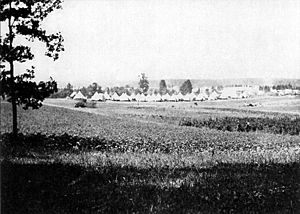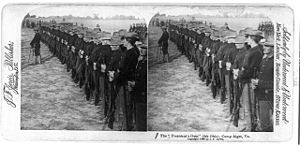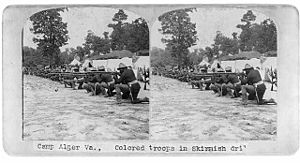Camp Alger facts for kids
Quick facts for kids Camp Alger |
|
|---|---|
| 1+1⁄2 miles from Dunn Loring | |
 |
|
| Site information | |
| Controlled by | United States |
| Site history | |
| Built | 18 May 1898 |
| In use | 1898 |
| Garrison information | |
| Past commanders |
Maj. Gen. William M. Graham |
| Garrison | Second Army Corps |
Camp Alger was a military base near Falls Church, Virginia. It was built on May 18, 1898, to help the United States prepare for the Spanish–American War. The camp was named after Russell A. Alger, who was the Secretary of War at the time. By August 1898, over 35,000 soldiers were staying at Camp Alger.
Contents
Where Was Camp Alger Located?
Camp Alger was about 1+1⁄2 miles from Dunn Loring, Virginia. Dunn Loring was a train station on the Southern Railway line. The camp was also about 7 miles from Washington, D.C. and 5 miles from Fort Myer.
The land at Camp Alger was hilly and had both open fields and wooded areas. It drained well, meaning water didn't sit around. The soil was a mix of clay and sand, which didn't let much water soak through.
Soon after the site was chosen, workers built storage buildings at Dunn Loring. The railway also added more tracks to handle all the supplies coming in for the soldiers.
The Second Army Corps at Camp Alger
The Second Army Corps was formed on May 7, 1898. On May 16, Major General William M. Graham was put in charge of this corps. All the soldiers who were part of this group were sent to Camp Alger.
General Graham arrived on May 19 and took command. He stayed in charge for as long as the camp was open. This corps was made up entirely of volunteer soldiers.
Soldiers started arriving on May 18. By the end of May, there were 18,309 officers and men at the camp. By the end of June, this number grew to 23,511. In total, 31,195 soldiers passed through Camp Alger.
Some brigades from Camp Alger were sent to Santiago, Cuba. Duffield's brigade left on June 15. Garretson's brigade left on July 5. They went to help General Shafter's army fighting in Cuba.
President McKinley's Visit to Camp Alger
The 8th Ohio Infantry Regiment, made up of U.S. Volunteers, arrived at Camp Alger on May 19, 1898. This regiment was nicknamed "McKinley's Own" or "The President's Own." This was because three of its companies came from President William McKinley's hometown of Canton, Ohio.
Another unit from Ohio was the Ninth Ohio Volunteer Infantry Battalion. This was an African American regiment. At Camp Alger, this battalion was first assigned to the Second Brigade, Second Division, of the Second Army Corps.
President William McKinley and his Cabinet visited Camp Alger on May 28, 1898. During their visit, two short films were made to record the event.
Life at Camp Alger: Water and Sanitation
The water supply at Camp Alger was very limited. It was barely enough for cooking and drinking, and only after about 40 wells were dug by June 25. There were no good places for soldiers to bathe nearby. The closest bathing spot was the Potomac River, 7 miles away.
Soldiers camped in both open and wooded areas. Those in the woods seemed to be fine. The latrines (outdoor toilets) were usually kept clean and were quickly enclosed for privacy.
The woods around the camp became quite dirty from human waste. However, the commanding officer put strict health rules in place. He worked hard to make sure soldiers followed them. His efforts were mostly successful.
Soldiers had enough tents. The different regimental camps were kept clean. Trash was properly burned. The food rations were plentiful and good quality. Field bakeries were set up in the camp and at Dunn Loring on August 2. These bakeries provided excellent bread for the corps.
In August, officials decided to reduce the number of soldiers at Camp Alger. One division was sent to Thoroughfare Gap. About two weeks later, it was decided to move the entire corps. This move was completed by early September.
During the time Camp Alger was open, the weather was often very hot. Some periods were also very rainy. These conditions, along with many flies, made life uncomfortable for the soldiers. However, the area around Washington was generally considered healthy.
Typhoid Fever at Camp Alger
A major challenge at Camp Alger was an outbreak of typhoid fever. This happened from July to November 1898.
Between May 18 and October 11, 71 soldiers died at Camp Alger. Another 34 died at Thoroughfare Gap. While these numbers might seem high, they were not considered unusual for the time. For example, the Seventh Illinois Regiment stayed at Camp Alger the whole time and only lost one soldier by December 14. This was a very good record.
Camp Alger was chosen because its site seemed suitable. However, because there wasn't enough water and no good bathing facilities, many believed it was not a good location. They felt it was closed at the right time.
On August 2, the 2nd Division of the corps marched 30 miles to Thoroughfare Gap. They stayed there for about a month.
In early September, the rest of the corps moved to Camp Meade. This camp was near Middletown, Pennsylvania.
Images for kids




